Conclusion
Kainan Jarrette and Diana Daly
Revisiting the Core Journey
We’ve gone over a lot in this book, and as we come to an end, it may be helpful to recap the areas we’ve hit.
 In Epistemology, we discussed how we know what we know. This included clarifying the difference between knowledge and belief, defining the characteristics of strong evidence, and covering the concept of The Burden of Proof. Ultimately, we learned that it’s important to think about why we believe what we believe.
In Epistemology, we discussed how we know what we know. This included clarifying the difference between knowledge and belief, defining the characteristics of strong evidence, and covering the concept of The Burden of Proof. Ultimately, we learned that it’s important to think about why we believe what we believe.
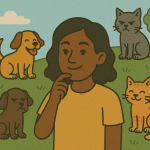 In Cognitive Bias, we covered how the brain’s hidden shortcuts and traps can influence how we engage with information. This included investigating biases like Confirmation Bias, Motivated Reasoning, and the Illusory Truth Effect. Ultimately, we learned that it’s important to be aware of and to manage our biases.
In Cognitive Bias, we covered how the brain’s hidden shortcuts and traps can influence how we engage with information. This included investigating biases like Confirmation Bias, Motivated Reasoning, and the Illusory Truth Effect. Ultimately, we learned that it’s important to be aware of and to manage our biases.
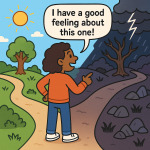 In Logic and Intuition, we compared rational analysis and gut feeling. This included going over the various ways our intuition fails us, including statistical thinking, large-scale systems, self-assessment, and situations that heavily involve our emotions and identity. Ultimately, we learned that reality often works in ways that feel contrary to our intuition.
In Logic and Intuition, we compared rational analysis and gut feeling. This included going over the various ways our intuition fails us, including statistical thinking, large-scale systems, self-assessment, and situations that heavily involve our emotions and identity. Ultimately, we learned that reality often works in ways that feel contrary to our intuition.
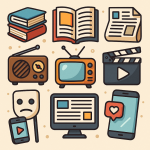 In Media Literacy, we discussed how to navigate information sources with a critical eye. This included covering the SIFT method for when you encounter a piece of media, as well as typical red flags and fake green flags of untrustworthy sources. Ultimately, we learned that credible media avoids emotional manipulation and provides context, evidence, and transparency.
In Media Literacy, we discussed how to navigate information sources with a critical eye. This included covering the SIFT method for when you encounter a piece of media, as well as typical red flags and fake green flags of untrustworthy sources. Ultimately, we learned that credible media avoids emotional manipulation and provides context, evidence, and transparency.
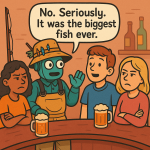 In AI Literacy, we covered some of the current state of AI tools and their pitfalls. This included dispelling some myths around AI, covering ways AI can fuel misinformation (such as hallucinations and absorbing bias), and tips for how to use AI wisely. Ultimately, we learned to have a healthy skepticism about the information AI provides, as well as to use AI as a collaborative tool rather than a replacement for our own thinking.
In AI Literacy, we covered some of the current state of AI tools and their pitfalls. This included dispelling some myths around AI, covering ways AI can fuel misinformation (such as hallucinations and absorbing bias), and tips for how to use AI wisely. Ultimately, we learned to have a healthy skepticism about the information AI provides, as well as to use AI as a collaborative tool rather than a replacement for our own thinking.
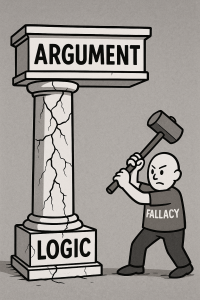 In the chapters on Logical Fallacies, we covered various errors in reasoning that commonly show up in misinformation. This included how to spot Red Herrings, Straw Man Arguments, Ad Hominem Attacks, False Equivalences, Slippery Slope Arguments, False Dilemmas, Appeals to Authority, and Hasty Generalizations. Ultimately, we learned that while logical fallacies can oftentimes feel appealing, they ultimately lack good reasoning and only serve to undermine an argument.
In the chapters on Logical Fallacies, we covered various errors in reasoning that commonly show up in misinformation. This included how to spot Red Herrings, Straw Man Arguments, Ad Hominem Attacks, False Equivalences, Slippery Slope Arguments, False Dilemmas, Appeals to Authority, and Hasty Generalizations. Ultimately, we learned that while logical fallacies can oftentimes feel appealing, they ultimately lack good reasoning and only serve to undermine an argument.
A Framework for Critical Thinking
In the interest of making a TL;DR section for this entire book, it may be useful to distill all of what we’ve covered into a Five Question Filter for when you encounter new media and information.
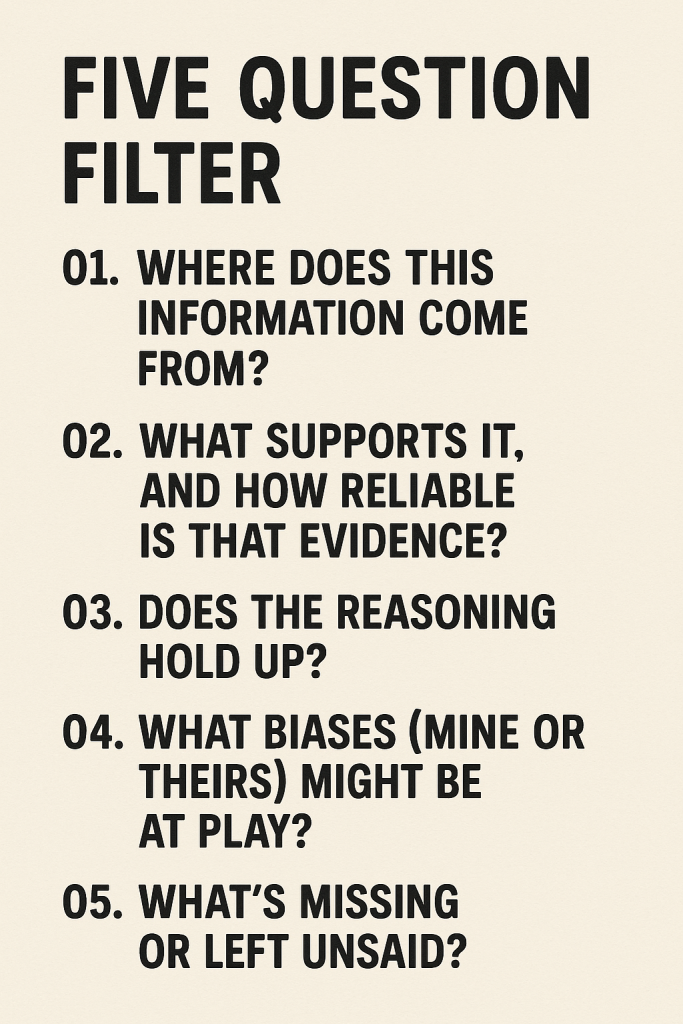
Empowerment, Humility, and Shared responsibility
Hopefully this book has given you some new tools and insights around critical thinking to help you better navigate the increasingly messy and complicated information landscape. Having the means to slow down when information feels overwhelming, ask better questions, and recognize when things feel lacking in credibility can give you greater confidence to engage with the media you encounter in your daily life without the fear of being manipulated.
But remember that critical thinking is a lifelong practice, and none of us are immune to mistakes. We’ll all be wrong about something at some point, so it’s important to stay humble and remain open to new evidence as it emerges. Intellectual humility — the ability to say “I was wrong” — isn’t a weakness, it’s the sign of a more honest and critical mind.
Lastly, we encourage you to share what you’ve learned with the people in your life and beyond. The information landscape doesn’t exist in a vacuum, it’s a massive interconnected system that we’re all ultimately responsible for. The more people that develop better critical thinking skills, the healthier that landscape becomes.
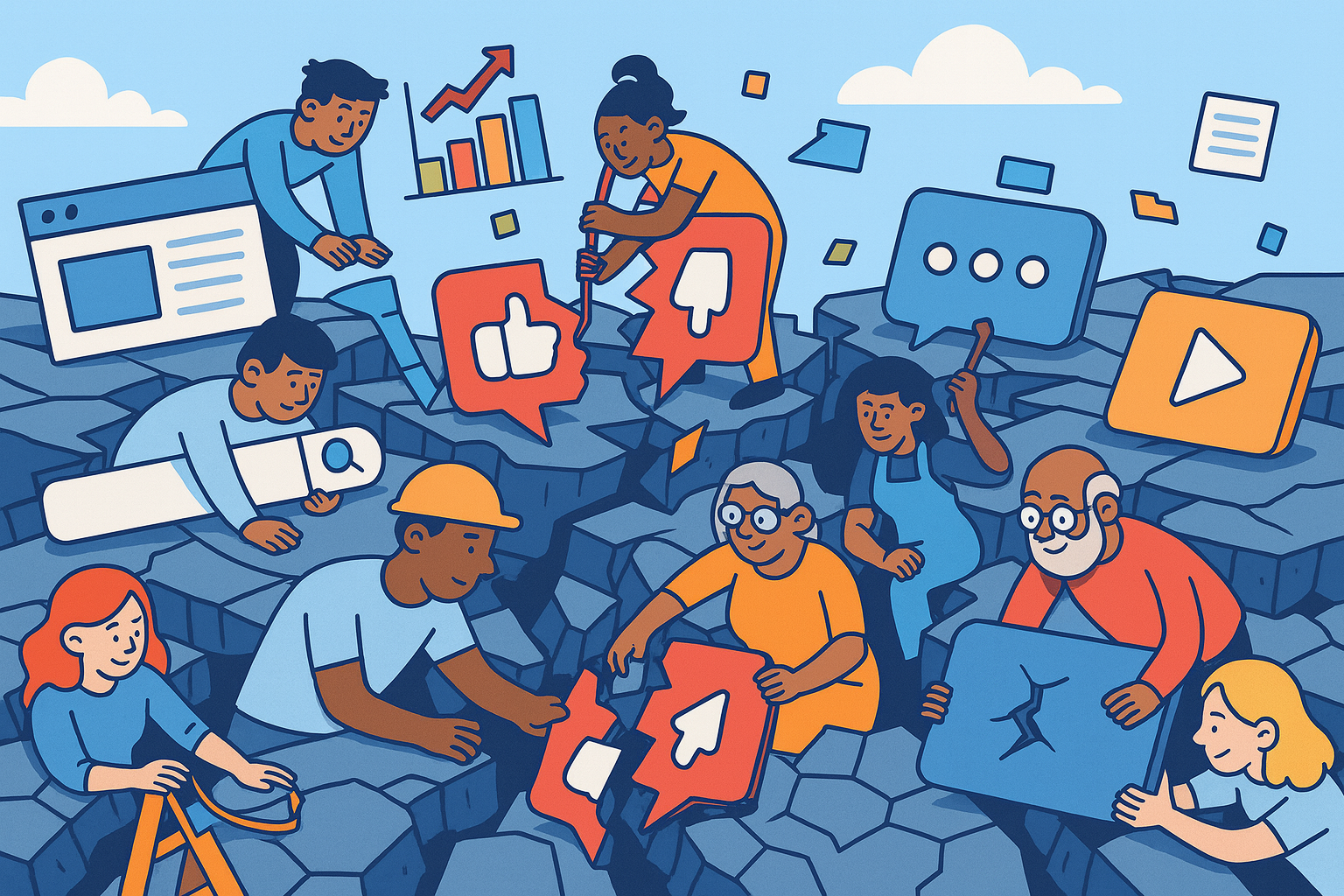
Media Attributions
- Testimony as Observation © ChatGPT is licensed under a CC0 (Creative Commons Zero) license
- Cats and Dogs (Happy and Grumpy) © ChatGPT is licensed under a CC0 (Creative Commons Zero) license
- I Have a Good Feeling © ChatGPT is licensed under a CC0 (Creative Commons Zero) license
- Types of Media © ChatGPT is licensed under a CC0 (Creative Commons Zero) license
- AI Tall Tale © ChatGPT is licensed under a CC0 (Creative Commons Zero) license
- Fallacies Undermine Pillars of Logic © ChatGPT is licensed under a CC0 (Creative Commons Zero) license
- Five Question Filter © ChatGPT is licensed under a CC0 (Creative Commons Zero) license
- Fixing the Landscape © ChatGPT is licensed under a CC0 (Creative Commons Zero) license
something we hold to be true that's supported by verifiable evidence and reasoning; justified belief
something we hold to be true regardless of evidence and reasoning
information offered to support or refute a belief; strong evidence can be observed, measured, independently verified, and cannot be accounted for by other explanations
the idea that it's the responsibility of the person making a claim to provide evidence for it
the tendency to look for, notice, and believe information that supports what you already think, while ignoring or dismissing information that challenges your beliefs
the tendency for people to process information in a way that reaches a conclusion they want to be true
the tendency to believe something is true simply because we've had repeated exposure to it
the practice of carefully analyzing information, beliefs, and arguments in order to make well-reasoned decisions, form justified beliefs, and avoid being misled

